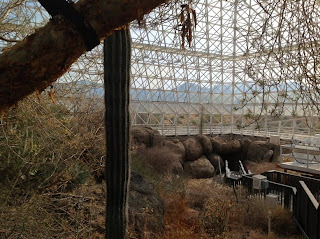Trip Meter Zero
Tucson, AZ
Wednesday November 28, 2012
Today the motorhome stayed put in Tucson at the Valley of the Sun RV Park while we drove the 45 miles out to Oracle, AZ and the Biosphere2 project. By now you know we don't exactly get an early start so we found ourselves doing household chores and finally getting underway at 10:30. While we are on the subject, I should give you a thumbnail sketch of what a typical day is like for an RV traveler. Our mornings are typically just like yours, we just get to do everything a little more leisurely. After showers and dressing we throw open the shades on all the windows to embrace the morning sun. Next the sun shows up all the dirt tracked in the day before (and all the popcorn that hit the floor) so sweeping is a daily regimine, followed by a wet Swiffer every other day. I should mention that this is our third "bus" (my nomenclature for the motorhome or MH) and all of them have had some variation of carpet and vinyl or carpet and hardwood in the front end and carpet in the bedroom. Well let me tell any of you that don't know- what is outside gets tracked inside, no matter how careful you are. Therefore we decided early on, to tear out the carpet and install vinyl flooring. Vinyl floors make the cleaning process much easier when you get back into the bus from a fuel stop and realize you have diesel or worse-yet grease on your shoes!
One part of this life that doesn't take long to get used to is that like you- we prepare and eat breakfast- the difference is- we get to actually finish our cup of coffee instead of throwing 1/3 of it down the sink and rushing off to work, or carrying it to the car and hoping not to spill it on the way to work! (Sorry but isn't it true?).
Having a home that bounces down the road, over speed bumps, and pot holes, means that things come loose, wear out, or fail completely. So some part of the day is set aside for replacing drawer glides, re-stringing blinds, washing, waxing the exterior, checking tire pressures, repairing faucets, checking fluid levels, adjusting exterior mirrors- well you get the idea. I'll expound on this more in the future- what you want to know is what Biosphere2 is like.
The Biosphere is called Biosphere2 because Earth is Biosphere1. To make this human experiment as accurate as possible the researchers had to first build an extremely tight envelope that would seal off BS2 from the Earth's environment. In fact this vessel is tighter even than the space shuttle. The BS2 has over 7 million cubic feet of space inside 6,500 sealed glass windows.
The Sphere is designed around 3 main climate zones. There is one section devoted to an equatorial rainforest One section is an ocean with a million gallons of water and an adjustable wave maker. It is stocked with sea creatures and sea plant life. The last section is devoted to a desert, where the climate can be changed to match the seasons and the rainfall can be varied to test the stress on the plant life. The whole ecosystem is supported by a basement level with acres of equipment in the way of pumps, air handlers, chillers, heaters, water filters and other essentials One of the most fascinating features of the Biosphere is the giant "lung" as they call it. The lung is their word for the expansion chamber that allows the atmosphere to heat up and expand during the day without exploding the exterior glass shell. This expansion chamber has a rubber-like membrane with a 6 ton aluminum disk in the center. As the air heats and expands the disk lifts off the legs that support it on the floor and it can rise as much as 52 feet to contain the "extra" volume of heated air. As the air cools and contracts the lung exhales air back into the domes. There have been two well known experiments done here with human occupation. The first was from 1991 to 1993 when 4 men and 4 women (all single and unrelated) lived in the biosphere for two years and 20 minutes. A second experiment was done later where 5 men and two women occupied the sphere for 6 months. All the rest of the time the sphere has been used for ecological studies some sealed and most not. The interior is still kept mostly as it was, but now that the University of Arizona has been given the facility the interior is being changed to support new research. The annual energy costs have run 1 million dollars a year. Last year the university took out sections of glass and installed louvers in specific areas- which has cut energy costs in half.Tomorrow is a travel day. We will save a lot of Tucson's attractions for another time, as we expect we'll be through here often in our travels. We are debating whether to stop in Benson and drive the car down to Tombstone, or drive on further to Silver City. I may not know the answer until we roll out the driveway tomorrow!








Comments
Post a Comment